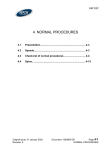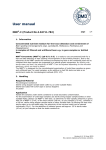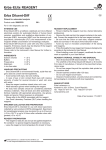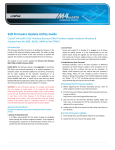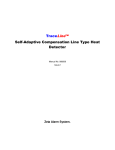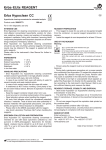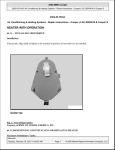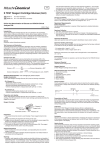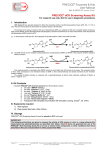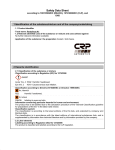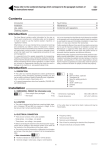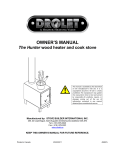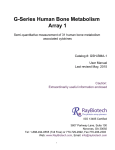Download EN MSDS-01 硝酸銀(2014.09.01.)英訳
Transcript
MSDS-01 Silver Nitrate (1/8) Materials Safety Data Sheet Silver Nitrate Created: May. 21, 2007 Revised: Sep. 01, 2014 1. Chemical Substances and Company Information Name of Chemical Substance: Company Name: Address: Tel.: Fax: Emergency Contact: Recommended Applications and Use Restrictions: Silver nitrate (I) Toyo Chemical Industrial Co., Ltd. 2-26-13, Naka-Izumi, Komae-City, Tokyo +81-3-3489-5152 +81-3-3488-1706 As above Silver plating, silver powder, antibacterial agents, mirrors, analytical test drugs, catalysts 2. Summary of Hazards GHS Classification Physicochemical hazards Damage to health Explosives Flammable/combustible gas Flammable/combustible aerosol Burnable/oxidation gas type High-pressure gas Flammable liquid Flammable solid Autoreactive chemicals Spontaneously combustible liquids Spontaneously combustible solids Self-heating chemicals Hydration-reactive flammable chemicals Oxidizing liquids Oxidizing solids Organic peroxides Metal-corroding substances Outside classification Outside scope of classification Outside scope of classification Outside scope of classification Outside scope of classification Outside scope of classification Outside classification Outside classification Outside scope of classification Outside classification Outside classification Outside classification Outside scope of classification Class 2 Outside scope of classification Cannot classify Acute (oral) toxicity Acute (percutaneous) toxicity Acute (inhaled: gas) toxicity Acute (inhaled: vapor) toxicity Acute (inhaled: dust) toxicity Acute (inhaled: mist) toxicity Skin corrosiveness and irritation Critical injury to eyes and eye irritation Respiratory organ sensitization Skin sensitization Germ-cell mutagenicity Carcinogenicity Reproductive toxicity Specific marker organ and systemic toxicity (single exposure) Class 4 Cannot classify Outside scope of classification Cannot classify Cannot classify Cannot classify Class 1A to 1C Class 1 Cannot classify Cannot classify Cannot classify Cannot classify Class 2 Class 1 (hematological system) Specific marker organ and systemic toxicity (single exposure) Class 3 (Airway irritation) Specific marker organ and systemic toxicity (repeated exposure) Class 1 (Lung, kidney, and cardiovascular systems) Inhalable respiratory organ harmfulness Cannot classify Ver. GHS-09 MSDS-01 Silver Nitrate (2/8) Damage to the environment Acute aquatic environmental harm Chronic aquatic environmental harm Class 1 Class 1 Label Elements Picture descriptions and labels: Cautionary terms: Danger Hazard information: Risk of fire accelerant: Oxidation substance Harmful if ingested Critical eye injury Critical skin chemical burns Suspected risk of malign influence on reproductive functions or fetus Risk of organ (hematological system) damage and respiratory organ irritation Organ (lung, kidney, and hematological system) damage due to long-term or repeated exposure Extremely strong poison to aquatic life Extremely strong poison to aquatic life due to long-term effects Cautions: [Safety Measures] Obtain the user manual before use. Do not handle until all safety precautions and readings are understood. Keep away from ignition sources such as heat, fireworks, naked flames, and high temperatures. No smoking. Do not spray on naked flames or other ignitions sources. Take preventive measures to avoid mixing with flammable or prohibited substances. When using the product, do not eat, drink, or smoke. Use only outdoors or in a well-ventilated area. Wear protective gloves, goggles, and face mask. Prevent contact with eyes, skin, and clothing. Do not inhale the dust. Wash hands thoroughly after handling. Avoid discharging into the environment. [Emergency Measures] If the substance contacts the eye, irrigate with water thoroughly for several minutes. If contact lenses can be removed easily, remove and wash them. If eye irritation persists, consult a physician and receive treatment. If clothing is spattered, promptly remove and isolate all soiled clothing. Wash contaminated clothing before reuse. If the substance adheres to the skin, wash using copious amounts of soap and water. If skin irritation occurs, consult a physician and receive treatment. If exposed or fear exposure, consult a physician and receive diagnosis treatment. If ingested, rinse out the mouth, and immediately consult a physician for treatment. If inhaled: Consult a physician promptly. If you feel unwell, consult a physician to receive diagnosis and treatment. Gather any leaks. [Storage] Lock the storage location. Store separately from flammable and other prohibited materials. Ver. GHS-09 MSDS-01 Silver Nitrate (3/8) [Disposal] If discarding contents or containers, entrust to a specialized waste disposal company. 3. Composition and Component Information Chemical Substance Chemical name or general name: Molecular formula (molecular weight): Silver nitrate (I) AgNO3 (169.87) Chemical characteristics (chemical or structural formula): Silver nitrate CAS No.: Reference numbers in gazetted list in japan(CSCL and ISHL): 7761-88-8 Impurities and stabilization additives that contribute to the classification: Concentration or concentration range: 1-8 No data 99.9% min. 4. Emergency Measures If inhaled: Causes irritation and chemical burns to the mucous membranes of the nose, throat, and bronchus. Blow nose and gargle. Consult a physician if necessary. Adhesion to skin: Irritates and corrodes skin. Wash with copious amounts of water. Consult a physician if the corrosion is severe. Contact with eyes: Causes a feeling of contamination, and irritates the membranes. Wash using dilute salt water and copious amounts of water, and then consult a physician. If ingested: Drink copious amounts of tepid water, lukewarm salt water, milk, and egg whites, etc., to induce vomiting, and then consult a physician. Predicted acute symptoms and delayed onset symptoms: Eye pain, and severe chemical burns Most important signs and symptoms: No information Protection of people implementing emergency measures: Rescuers should wear suitable protective equipment according to the circumstances. Special precautions for physicians: No information 5. Measures during Fires Flame retardants: Water jets, foam retardants, powder retardants (excluding hydrogen carbonate), dry sand, etc. Ver. GHS-09 MSDS-01 Silver Nitrate (4/8) Characteristic dangers: There is a risk of exacerbating fires. Strong heat causes harmful gas (NOx) to be emitted, so wear protective equipment when firefighting. Extinguishants that must not be used: Carbon gas, and hydrogen carbonate powder retardants Characteristic extinguishing methods: Promptly move containers in the vicinity of the fire to a safe location. If moving is not possible, scatter water on the containers and their surroundings to cool. Protection of firefighters: Fight fire from upwind, and avoid inhaling poisonous gasses, etc. Wear respiratory protectors depending on the circumstances. Keep upwind all personnel unnecessary to disaster prevention activities. 6. Measures during Leaks Physical precautions, protective equipment, and measures during emergencies: Cordon off the periphery of the dispersal area to prohibit the entrance of personnel. When working, wear protective equipment to prevent the inhalation of spattered adhesions, dust, and gas, etc., and work from upwind. Remove all ignition sources. Environmental precautions: Make sure there is no discharge of the product or unprocessed thick effluent into rivers, etc. Collection and neutralization: Collect any spatter in a container, and then add saline to create silver chloride and collect the silver, and then flush away using copious amounts of water. Preventing secondary accidents: Prevent inflow to drainage ditches, sewers, cellars, or sealed locations. 7. Handling and Storage Precautions Handling Technical measures: No naked flames. Avoid shock and high temperatures. Beware of contact with flammable materials, organic materials, and reducing substances, etc. Local exhaust and overall ventilation: Ideally, handle in locations with local exhausters and overall ventilators. Precautions for safe handling: Do not handle until all safety precautions and readings are understood. Prohibit the use of high-temperature devices, sparks, and naked flames in the vicinity. When using the product, do not eat, drink, or smoke. Do not touch, inhale, or drink. Prevent contact with eyes, skin, and clothing. Do not inhale dust, fumes, or mist. Use only outdoors or in a well-ventilated area. Wash hands thoroughly after handling. If not using deliberately, avoid discharging into the environment. Storage Technical measures: Storage conditions: Store hazardous materials in their storage location, and install the lighting, illumination, and ventilation necessary for handling. Avoid contact with heat, shock, friction, flammable materials, reducing substances, and oxidants during storage. Avoid storing with foodstuffs. Prevent spatter, leaks, discharge, seepage into the floor, and theft, etc., during storage. Ver. GHS-09 MSDS-01 Silver Nitrate (5/8) Incompatible substances: Avoid contact with heat, reducing substances, and oxidants during storage. Container and packing materials: Airtight containers (glass, polyethylene, stainless steel, etc.) 8. Exposure Avoidance and Protection Measures Control concentration: No data Tolerable concentration: Japan Society for Occupational Health (2007) 0.01mg/m3 (as Ag) ACGIH (2007 version) TWA 0.1mg/m3 (as Ag) TWA 0.01mg/m3 (as soluble Ag) Equipment measures: Install local exhausters, and eye and hand washing facilities, in the handling locations. Protective Equipment Respirator: Poison masks (respirator during fires), and dust masks Hand protective equipment: Wear protective gloves. (Rubber gloves, etc.) Eye protective equipment: Wear eye protective equipment. (Goggles, etc.) Skin and body protective equipment: Wear protective face equipment, clothing, and protective shoes, etc. (Protective clothing, protective boots, etc.) Hygiene measures: When using the product, do not eat, drink, or smoke. Wash hands thoroughly after handling. 9. Physical and Chemical Properties Physical properties, shape, and color, etc.: Colorless to white crystalline powder Odor: pH: Melting point and coagulation point: Boiling point, initial boiling point, and boiling range: Slightly acidic odor Weak acidity when dissolved in water 212ºC (melting point) No data Ignition point: Explosion range: Vapor pressure: Vapor density (vapor=1): Specific gravity (density): Solubility: No data No data No data No data 19 d 4.35 Water: 20ºC 215.7 g/100ml Ethanol 15ºC 3.8 g/100g Acetone 15ºC 0.35 g/100g Octanol/water partition coefficient: No data Spontaneous ignition temperature: No data Dissolution temperature: Dissolves at 444℃ Odor threshold value: No data Vaporization speed (butyl acetate=1): No data Burnability (solids and gas): No data Viscosity: No data Ver. GHS-09 MSDS-01 Silver Nitrate (6/8) 10. Stability and Reactivity Stability: Has properties that oxidize other substances, and when mixed with flammable substances, dissolves due to heat/shock/friction, etc., to cause fierce burning. In the presence of organic residue, the silver separates and discolors due to light. Possibility of harmful reactions: Substance is an oxidant, and reacts with flammable substances and reducing substances. Conditions to be avoided: Light and heat Incompatible substances: Flammable substances and reducing substances Hazardous degradable organisms: Silver and NOX 11. Harmfulness Information Acute toxicity: Oral lethal dose 10g Mouse oral: LD50; 50mg/kg Rat oral: LD50; 1,173mg/kg Mouse intraperitoneal: LD50; 17mg/kg Rat intraperitoneal: LD50; 83mg/kg Skin corrosiveness and irritation: Mild skin irritation. Skin irritation: Rabbit; 500mg/24hr mild Critical injury to eyes and eye irritation: Eye irritation: Rabbit; 10mg strong Respiratory organ and skin sensitivity: No data Germ-cell mutagenicity: No data Carcinogenicity: No data Reproductive toxicity: No data Specific marker organ and systemic toxicity (single exposure): No data Specific marker organ and systemic toxicity (repeated exposure): Risk of organ (skin and respiratory organ) damage due to long-term or repeated exposure. Inhalable respiratory organ harmfulness: No data 12. Environmental Impact Information Ecotoxicity: Toxic to aquatic environment life forms, and affects the ecosystem. Persistence and degradability: No data Bioaccumulation: No data Ver. GHS-09 MSDS-01 Silver Nitrate (7/8) 13. Disposal Precautions: Residual waste: Collect the silver using a roasting and reduction process, or an oxide precipitation process. During roasting, gasses containing NOx are emitted, so do not roast using an incinerator without cleaning equipment. (Ideally, entrust to a specialized company.) Dirty containers and packaging: Suitably process containers according to the relevant regulations and local government standards. When disposing of empty containers, make sure to discard the contents completely. 14. Shipping Precautions International Regulations Maritime Regulations Information Aviation Regulations Information UN No.: Proper Shipping Name: Class: Sub Risk: Packing Group: Marine Pollutant: Japanese Regulations Land Regulations Information Obey International Maritime Organization regulations. Obey International Civil Aviation Organization/International Air Transport Association regulations. 1493 Silver nitrate 5.1 II Obey Poisonous and Deleterious Substances Control Law and Fire Services Act regulations. Maritime Regulations Information Aviation Regulations Information UN No: Proper Shipping Name: Class: Sub Risk: Packing Group: Obey Ship Safety Law regulations. Obey the Civil Aeronautics Law. 1493 Silver nitrate 5.1 Special Safety Measures During transport, avoid direct sunlight, and load so that the containers are not damaged, corroded, or leaking, and secure the load to prevent toppling. II Do not transport together with food or livestock feed. Yellow card display is required during transport. Urgent Measures during a Crisis Policy Number 140 15. Applicable Laws Fire Service Act: Class 1 hazardous material: Nitrates; Class 3 oxidizing solid (designated quantity: 1,000㎏) Poisonous and Deleterious Substances Control Law: Deleterious substance not for pharmaceutical use Industrial Safety and Health Law: Hazardous material (oxidizing substance) Notifiable substance (Article 57-2, government ordinance Article 18-2 attached table No. 9-137) Ver. GHS-09 MSDS-01 Silver Nitrate (8/8) Pharmaceutical Affairs Law: Powerful drug, and designated drug PRTR: Class 1 designated chemical substance (attached table 1-82) Act on Port Regulations: Hazardous material (oxidizing substance) Civil Aeronautics Act: Oxidizing substance (class 2) Regulations for the carriage and storage of dangerous goods in ship: Oxidizing substance (class 2) 16. Other Information Bibliography: Reagent guidebook (Revised 2003) Collection of Poisonous Materials Standard Notifications (Revised and enlarged edition 1991) Dictionary of Chemistry (1987 30th printing: Kyoritsu Shuppan) Chemistry and Applications of Precious Metal Elements (1984 Kodansha) Hazardous Materials Safety Management (Ver. 4 Japan Association for Safety of Hazardous Materials) 12996 Chemical Products (1996 The Chemical Daily) Chemical Substances Control Law chemical substance (METI) Collection of Chemical Product Laws (1992 The Chemical Daily) RTECS (2008) Journal of the Japan Society for Occupational Health (2007) GHS classification results database: NITE website GHS model MSDS information: JISHA website *Caution: Hazard and harmfulness evaluations were created using the data and information available at the current time, but is not necessarily thorough, so handle with care. Further, the data and evaluations described herein are not in any way guaranteed. The descriptions refer to normal handling, so for special handling, first implement safety measures conforming to the new application and methods of use. This MSDS is translated into English.(Original version is Japanese) Ver. GHS-09








